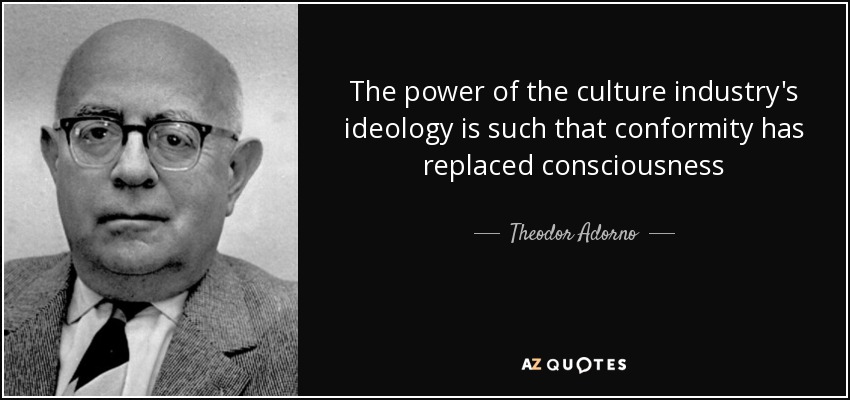
Every time I open Instagram or TikTok, it feels like the feed was perfectly designed for me. The videos seem personal, as if the app somehow knows what I want to see. But after a few minutes, the same sounds, filters and poses start looping endlessly. What feels like individual choice might actually be part of a bigger pattern of control. More than seventy years ago, Theodor Adorno and Max Horkheimer described this dynamic through the idea of the culture industry ŌĆö a system that turns culture into a product and pleasure into obedience.

ŌĆśTheir ideas were later collected in AdornoŌĆÖs The Culture Industry, shown here, which expands on the critique of mass-produced culture.ŌĆÖAdorno and Horkheimer (1944/2006) explain that under capitalism, culture begins to function like an industry. Films, radio programmes and pop music are produced according to formulas that guarantee profit and predictability. This process, which they call standardisation, makes cultural products feel safe and familiar. At the same time, pseudo-individualisation gives audiences the illusion of choice ŌĆö every song or movie seems different, but all follow the same pattern. For them, the danger is that entertainment transforms conformity into pleasure, so people stop questioning what they consume. ItŌĆÖs a way of keeping everyone satisfied, but not necessarily free.
Paddy Scannell (2007) shows how this debate began alongside Paul LazarsfeldŌĆÖs audience research in 1930s America. Lazarsfeld focused on measuring media effects to help industries target audiences, while the Frankfurt School were more interested in how those same systems maintain power. Scannell points out that both approaches reveal how communication creates social order. What I find most interesting is AdornoŌĆÖs idea that control doesnŌĆÖt always look like control; it can feel like enjoyment.
When I think about TikTok, that description feels very accurate. The app celebrates creativity, but only within certain limits. The ŌĆ£For YouŌĆØ page rewards repetition ŌĆö the same sounds, transitions and trends that keep users engaged. Every scroll fuels a data economy that predicts what we want and sells it back to us. Even rebellious or ironic content quickly becomes another trend to monetise. ItŌĆÖs like AdornoŌĆÖs warning has simply been updated for the algorithm age: the culture industry hasnŌĆÖt disappeared, it has become interactive.

ŌĆ£Every clip looks unique, but they all follow the same pattern ŌĆö the algorithmŌĆÖs illusion of choice.ŌĆØ
I donŌĆÖt think everything about this is negative though. People are smart. They find ways to remix trends, make fun of them, and sometimes even reveal how the system works. I like to believe thereŌĆÖs still room for something real to come through all the repetition. Maybe thatŌĆÖs what keeps culture alive. But I canŌĆÖt help wondering, if everything is already predicted by the algorithm, how much of our creativity is actually ours?
Reference’╝Ü
Adorno, T.W. and Horkheimer, M. (1944/2006) The Culture Industry: Enlightenment as Mass Deception. In Durham, M.G. and Kellner, D.M. (eds.) Media and Cultural Studies: KeyWorks. 2nd edn. Malden, MA: Blackwell, pp. 41ŌĆō72.
Adorno, T. (n.d.) Quote: ŌĆ£The power of the culture industryŌĆÖs ideology is such that conformity has replaced consciousness.ŌĆØ AZ Quotes. Available at: https://www.azquotes.com/quote/802548
Scannell, P. (2007) Media and Communication. London: SAGE Publications, pp. 9ŌĆō30.

